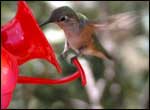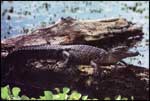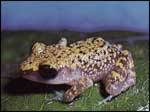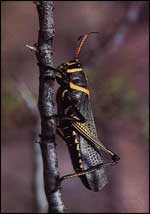How Does A Warm-blooded Animal Get Body Heat Answers
Related Young Naturalist Links
:
Warm- and Cold-Blooded Animals
No matter what the outside temperature may be, your body, similar a living furnace, works to maintain a constant internal temperature. It generates heat by called-for the nutrient you eat. All mammals and birds are capable of generating this internal rut and are classed as homoiotherms (ho-MOY-ah-therms), or warm-blooded animals. Normal temperatures for mammals range from 97° F to 104° F. Virtually birds take a normal temperature between 106° F and 109° F.

Larger animals, such equally these prairie dogs, do not use as much energy to produce the oestrus required to keep their larger bodies warm.
A portion of the brain known as the hypothalamus (howdy-po-THAL-ah-mus) is the thermostat that controls your torso's furnace. This thermostat is set at 98.6° F, but a caste or and so higher or lower is within the normal range for a man. In fact, your body temperature varies with the fourth dimension of mean solar day. It is at its lowest just before yous go upward in the morning time, rises to a peak in the afternoon, and so falls once again while yous sleep at night. Strenuous activity raises the trunk temperature. Illness also may cause a greater rise or drop in the normal temperature.
Nerves in the skin and deep inside the body send temperature messages to the hypothalamus. It compares the temperatures of these areas with that of the brain and, if they are too low or also high, information technology sends messages to nerves and glands to help increment or decrease the heat. When you are cold, a message from the brain causes your muscles to shiver. This generates a trivial heat and starts warming the body. When you are too hot, a message triggers your sweat glands. Evaporation of the resulting perspiration cools the skin. Some other message may dilate (overstate) the blood vessels under the pare so more claret can come up to the surface and more than oestrus tin escape through the skin to the air.

A tiny hummingbird must refuel its body furnace every 10 to xv minutes during the day to maintain its torso heat.
Panting is another cooling method used by mammals with few sweat glands. Moisture evaporates from the oral cavity and tongue to cool the overheated body. Birds cannot sweat, but they go rid of backlog body heat past breathing information technology out. Special air sacs, which extend from the lungs, increment the corporeality of air the birds can exhale in and out.
Warm-blooded animals can be as agile in winter every bit summertime, just their bodies must have plenty of nutrient to burn for additional heat. Birds, with their higher body temperatures, often find it difficult to locate enough food when winter's lower temperatures arrive, so nearly of them drift to warmer climates where their bodies practice non have to piece of work as hard to maintain rut.

Cold-blooded animals cannot generate their ain trunk heat, merely they do regulate it by changing their environment. Alligators and other reptiles oftentimes lie in the sun to warm themselves. On the other hand, they cool off by taking a dip in the water, moving into the sade of a rock or crawling into a burrow in the ground.
Heat escapes from the torso through the skin. Layers of clothing assist you retain your body oestrus in the winter. Other mammals must rely on layers of fat or a fur covering to insulate them from the common cold and retain their torso heat. In extremely cold climates, you won't find mammals with large ears or long tails. A lot of extra food would be required to supervene upon the heat lost from these large surfaces—food that would exist extremely hard to find.
Smaller animals must produce more rut to continue warm than larger ones. To empathize this, pretend that a 3-inch-foursquare box is a pocket-sized animate being and a half-dozen-inch-square box is a larger animal. On its six exposed sides, the small animal has 54 square inches of pare. The larger beast has 216 foursquare inches of skin, or iv times equally much. The within oestrus-producing area of the small animal is 27 cubic inches, but the within of the larger animal contains 216 cubic inches, which is eight times bigger. If information technology takes i unit of energy for each cubic inch to warm ane square inch of pare, the smaller animal must burn twice every bit much energy to keep its pare at the temperature of the large creature's skin. This means information technology must produce twice as much oestrus.

When temperatures drop, common cold-blooded animals become less active, even sluggish.
Because small-scale bodies must produce so much heat to stay warm, the size of warm-blooded animals is limited. If the animal were too small, information technology could not digest nutrient fast plenty to produce oestrus as apace as warmth could exist lost through the skin. During the day a tiny hummingbird refuels its furnace with food every ten to fifteen minutes. If it were not able to slow its body down at night to about one-twentieth of its daytime energy by going into a hibernation-like torpor, the absurd night air of even a warm climate would endanger the hummingbird'southward life.
Torpor is a type of sleep from which an animal cannot be awakened apace. Its body temperature drops to that of its environs, and the heartbeat and breathing are slowed downwards greatly. If the temperature drops besides low, the animate being will freeze and never awaken from torpor. True hibernators pass in and out of torpor throughout the winter.
Animals that cannot generate internal oestrus are known every bit poikilotherms (poy-KIL-ah-therms), or common cold-blooded animals. Insects, worms, fish, amphibians, and reptiles autumn into this category—all creatures except mammals and birds. The term cold-blooded is a little misleading considering poikilotherms tin can take very warm body temperatures in the tropics. Cold-blooded really means the creature's body temperature is basically the aforementioned as its surroundings. A fish swimming in 40° F water will have a trunk temperature very about xl° F. The aforementioned fish in 60° F h2o will have a body temperature near threescore° F.

After a cool night, a grasshopper may be as well stiff and cold to hop until the morning dominicus warms its body.
Since cold-blooded animals cannot generate their own heat, they must regulate their body temperature past moving to dissimilar environments. Yous probably take seen a cadger, turtle, or alligator lying effectually basking in the sun. Information technology does this to raise its body temperature. When it gets likewise warm, it moves into the shade, takes a dip in the h2o, or burrows under a stone or into the ground to cool off. When temperatures drop, cold-blooded animals become less active, even sluggish. If an insect becomes as well cold, its wing muscles cannot movement fast plenty for it to fly. Some moths vibrate their wing muscles, an action similar to your shivering, and the contracting muscles produce enough heat for takeoff. Subsequently a cold night, a grasshopper often is besides potent and cold to hop. However, in one case the sun'southward rays have warmed information technology up, information technology can leap around as usual.
Extreme changes in ecology temperatures can exist fatal to the common cold-blooded animal. Equally water temperatures increase, oxygen content is reduced. Raising the temperature from 41° F to 95° F will cut the oxygen level in half. A fish experiencing this desperate rise in temperature must pump twice equally much water across its gills to get the same amount of oxygen it received when the temperature was lower. The increased action also increases the fish's need for oxygen, which compounds the problem. Equally a result, the fish may die from a lack of oxygen, not estrus.
Many insects dice when temperatures drop, but side by side year'due south supply winters in eggs, cocoons, or some other protective covering. They sally or hatch when jump or summertime temperatures return. Reptiles burrow into the ground or find a den in which to live until surface temperatures are more favorable. In fact, sunny winter days bring many of them out to warm themselves and look for food. Extremes of heat and cold are hard on all animals. But both warm-blooded and common cold-blooded animals accept adjusted to normal weather changes.
Additional Information:
Ilo Hiller
1983 Warm- and Cold-Blooded Animals. Young Naturalist. The Louise Lindsey Merrick Texas Environment Series, No. 6, pp. 16-19. Texas A&1000 University Press, College Station.
Source: https://tpwd.texas.gov/publications/nonpwdpubs/young_naturalist/animals/warm_and_cold_blooded_animals/
Posted by: ferraraemparch.blogspot.com

0 Response to "How Does A Warm-blooded Animal Get Body Heat Answers"
Post a Comment